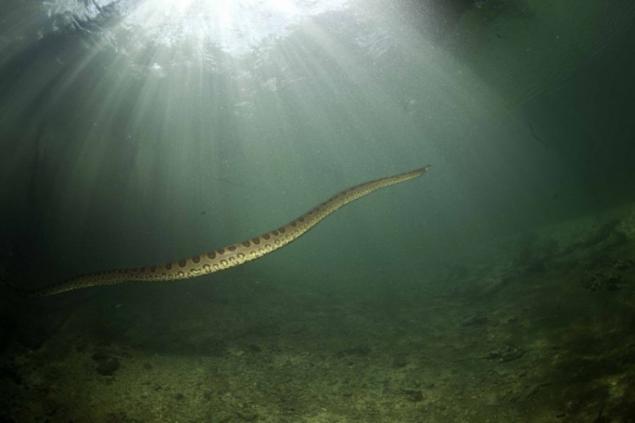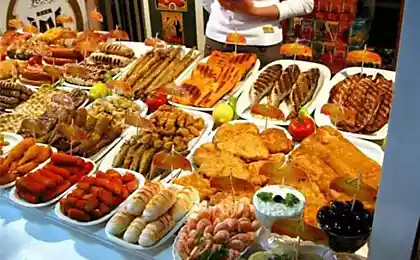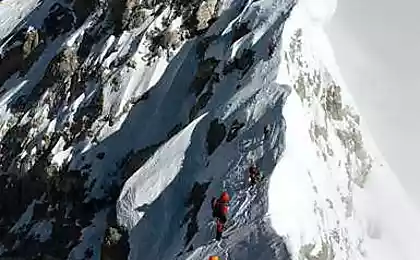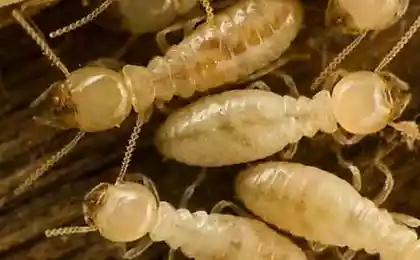1654
He risked his life to photograph one of the most dangerous creatures on the planet ...
Diver Switzerland risked their lives for exclusive material and sank to the bottom of the Amazon River in Brazil, to swim with giant anacondas. Diver managed to make stunning photos directly anaconda in its natural habitat, under vodoy.
Voyager spent 10 days in the Brazilian state of Mato Grosso do Sul, during which he was able to capture on camera the six species of anaconda. the largest of all existing snakes.
Huge predator calmly led a normal life, swimming in the murky waters of the river, or basking in the sun after a meal, not paying attention to the person with too emboldened fotoapparatom.
"Of course, anything is possible, but I do not think she would have eaten me. Fortunately for me, the anaconda that swallowed his only regular production and did not look after my second course. I was so close to her that I could touch it, if I wanted to, of course, "- said 53-year-old photographer.
Anaconda is almost entirely aquatic life. She kept quiet, of oblong bayous, creeks, oxbow lakes and small lakes of the Amazon and Orinoco.
The adult anaconda in nature practically no enemies.
"At first it was very scary because I had never before so close to the snakes did not fit, everyone knows that they are very dangerous. But I realized that nothing would happen if with respect to these creatures. At least, they are big and you can watch their reactions and behavior, "- said Franco.
Currently, the largest known giant anaconda has a length of about 9 meters and a weight of about 130 kg, it is in the New York Zoological Obschestve.
The main body color anaconda - grayish-green with two rows of large brown spots round or oblong, alternating in a checkerboard pattern. On the sides of the body there is a number of smaller yellow spots, surrounded by black rings. This effectively hides the color of the snake when she hides in calm water, covered with brown leaves and bunches of seaweed. Females are much bigger and stronger samtsov.
Anaconda occupies the entire tropical part of South America east of the Andes: Venezuela, Brazil, Colombia, Ecuador, eastern Paraguay, northern Bolivia, northeast Peru, Guyana, French Guiana, as well as the island of Trinidad.
Due to the inaccessibility of the anaconda habitat scientists is difficult to assess its strength and follow the dynamics of the population.
In zoos the world anacondas much, but they take root in captivity quite difficult. The maximum term of life in a terrarium anaconda - 28 years, but usually these snakes in captivity live 5-6 let.
Anaconda feeds on a variety of mammals, trapping them in the water. She catches tapirs, peccaries, agoutis, capybaras. Not just a case where the anaconda devouring even the jaguar. For lunch anaconda often fall waterfowl, small caimans, turtles, and snakes - at least at the zoo once anaconda strangled and ate 2, 5-meter pitona.
Like all boas, the anaconda still waiting for prey, and when that approach, grabs her lightning cast and choking, throwing his ring body (contrary to popular belief, the anaconda, like other boas do not crush the victim and not break her bones, and compresses it, and not It gives breathe, and she dies of suffocation). Like everyone, without exception, snake, anaconda swallows the prey whole, much stretching, and thus fall glotku.
Despite the fact that there is only one authentic case of death of a person from the attack snakes, anacondas gained fame "eaters" of people thanks largely to Hollywood movies-trilleram.








Voyager spent 10 days in the Brazilian state of Mato Grosso do Sul, during which he was able to capture on camera the six species of anaconda. the largest of all existing snakes.
Huge predator calmly led a normal life, swimming in the murky waters of the river, or basking in the sun after a meal, not paying attention to the person with too emboldened fotoapparatom.

"Of course, anything is possible, but I do not think she would have eaten me. Fortunately for me, the anaconda that swallowed his only regular production and did not look after my second course. I was so close to her that I could touch it, if I wanted to, of course, "- said 53-year-old photographer.
Anaconda is almost entirely aquatic life. She kept quiet, of oblong bayous, creeks, oxbow lakes and small lakes of the Amazon and Orinoco.
The adult anaconda in nature practically no enemies.
"At first it was very scary because I had never before so close to the snakes did not fit, everyone knows that they are very dangerous. But I realized that nothing would happen if with respect to these creatures. At least, they are big and you can watch their reactions and behavior, "- said Franco.
Currently, the largest known giant anaconda has a length of about 9 meters and a weight of about 130 kg, it is in the New York Zoological Obschestve.

The main body color anaconda - grayish-green with two rows of large brown spots round or oblong, alternating in a checkerboard pattern. On the sides of the body there is a number of smaller yellow spots, surrounded by black rings. This effectively hides the color of the snake when she hides in calm water, covered with brown leaves and bunches of seaweed. Females are much bigger and stronger samtsov.

Anaconda occupies the entire tropical part of South America east of the Andes: Venezuela, Brazil, Colombia, Ecuador, eastern Paraguay, northern Bolivia, northeast Peru, Guyana, French Guiana, as well as the island of Trinidad.
Due to the inaccessibility of the anaconda habitat scientists is difficult to assess its strength and follow the dynamics of the population.
In zoos the world anacondas much, but they take root in captivity quite difficult. The maximum term of life in a terrarium anaconda - 28 years, but usually these snakes in captivity live 5-6 let.

Anaconda feeds on a variety of mammals, trapping them in the water. She catches tapirs, peccaries, agoutis, capybaras. Not just a case where the anaconda devouring even the jaguar. For lunch anaconda often fall waterfowl, small caimans, turtles, and snakes - at least at the zoo once anaconda strangled and ate 2, 5-meter pitona.

Like all boas, the anaconda still waiting for prey, and when that approach, grabs her lightning cast and choking, throwing his ring body (contrary to popular belief, the anaconda, like other boas do not crush the victim and not break her bones, and compresses it, and not It gives breathe, and she dies of suffocation). Like everyone, without exception, snake, anaconda swallows the prey whole, much stretching, and thus fall glotku.

Despite the fact that there is only one authentic case of death of a person from the attack snakes, anacondas gained fame "eaters" of people thanks largely to Hollywood movies-trilleram.































